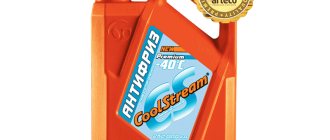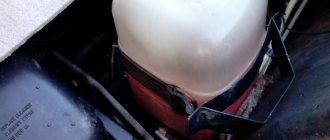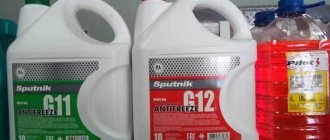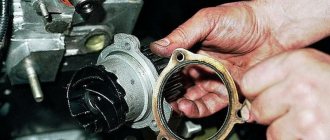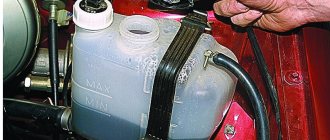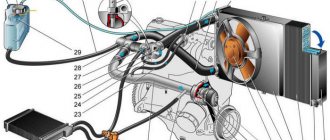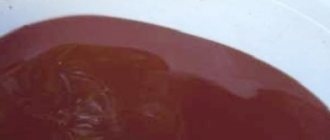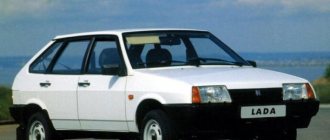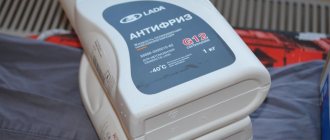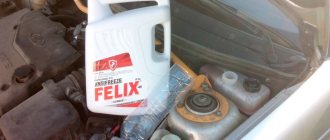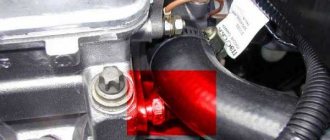To cool the engine in cars, a special liquid called antifreeze or antifreeze is used. The coolant is also used in the VAZ 2114 car and performs the functions of not only cooling the engine, but also heating the vehicle interior.
Many car owners are wondering whether it is necessary to change the coolant and when it should be replaced.
This article talks about replacing the coolant on a VAZ 2114 car, namely the timing of replacement, methods for replacing and flushing the internal combustion engine.
Do I need to change the coolant?
There are a huge number of different opinions about replacing the coolant, but only one of these statements is correct. The coolant definitely needs to be changed, but this can be done much less frequently than changing the same car oil.
The coolant on the VAZ 2114 should be replaced at 40,000 km, but no later than once every five years.
What to do if the car was bought secondhand and it is not known when the last replacement was carried out?
In this case, it is recommended to evaluate the condition of the fluid after purchase and, if necessary, replace it.
Preparation for replacement and necessary tools
You should start by preparing the car and workplace. The machine is placed on an overpass or above an inspection hole. It is recommended to leave it on the handbrake and at speed. And place “corners” under the wheels: stoppers to hold the car. After installation, it is worth checking the position of the machine. It should be level, or the front should be higher than the back. Other options are unacceptable.
The next stage of preparation for replacing the coolant in the VAZ 2107 is choosing tools . The list is short:
- A key for 13. It is recommended to additionally take a key for 8 and an adjustable key for 30. It is worth considering that used cars do not always use “original” spare parts. Therefore, the sizes of nuts and bolts may differ from the standard. Because of this, experienced drivers prefer to keep a set of keys of different sizes on hand.
- Screwdriver Set. It is worth having a flathead and Phillips screwdriver with you.
- Container for draining used antifreeze. Volume - 11-12 liters.
- Hose for the drain hole on the engine. Needed to remove antifreeze from the internal circuit of the system.
- Antifreeze to replace. Recommendations for selection and required volume are described above.
- Funnel for filling new coolant.
- WD-40 or equivalent. Used to remove dirt and rust from bolts and plugs.
Safety recommendations:
- You need to work on a cool engine. If the antifreeze is hot, allow it to cool. It must be remembered that the operating temperature of the coolant is 60-90 degrees. You cannot open the radiator and check the condition of the antifreeze. After all, the liquid, while hot, is under pressure in the system.
- The machine should be carefully secured in place. Any negligence in this matter can result in serious injury.
- Replacement is carried out in a well-ventilated area. It is worth remembering that antifreeze fumes are bad for your health.
- During operation, antifreeze must not enter the body. In particular, it should not come into contact with the eyes, mouth or respiratory tract.
Now you can proceed to the actual antifreeze replacement procedure. Conventionally, it is divided into three stages : draining the old coolant, flushing, and filling in new antifreeze. Each stage should be described separately.
Draining old fluid
First, you should remove the crankcase protection . And here it is worth remembering - on Zhiguli cars it is often in a deplorable state. The plate should be washed before removal. The bolts are treated with WD-40 to remove rust. If necessary, the entire part is cleaned of rust. The bolts are carefully unscrewed and the crankcase protection is removed. An important point: on old cars, the bolts rust and become brittle. If handled carelessly, they may break.
The heater lever opens in the cabin . It is transferred to the maximum position. There is no need to start the stove itself. Then the radiator filler neck and expansion tank are opened. This is done to speed up the draining. Then a container for used antifreeze is placed under the radiator drain hole. There are two options for draining the liquid.
They depend on the radiator model:
- Option with the “native” radiator of the VAZ 2107. The latest models of Zhiguli have a special tap for draining antifreeze. This faucet is treated with WD-40: it has a habit of turning sour. Then it opens and the liquid drains out.
- If a radiator from older models of the series is installed. There is no drain hole provided here. Therefore, the liquid is drained in one of two ways: The fan switch off sensor is unscrewed. It is located on the inside of the radiator, on the right (if you are facing the car). It will require a 30 key.
- Remove the hose from the lower radiator pipe.
After draining the coolant from the radiator, the internal circuit of the system should be emptied. You need to find the drain plug on the cylinder block. It looks like a 13mm wrench bolt. Use the appropriate wrench to unscrew the plug. The waste liquid is drained. To do this, you need to run the used coolant through a hose into a pre-prepared container.
The next step is draining the antifreeze from the expansion tank . You need to unfasten the container fastening belt. She herself is lifted 30-40 cm up. This will allow the remaining liquid to enter the radiator. From there it is drained using the method already described.
Flushing the cooling system
There are three ways to flush the cooling system: with water, household chemicals, and special compounds. And you should choose a method based on your preferences and the condition of the car. However, there is one important recommendation. Washing is not considered a mandatory procedure.
But there are a number of situations when it must be done:
- When switching to another coolant. The composition of different brands of antifreeze may differ. And mixing these liquids is not recommended. Even if both coolants are of high quality. This requires draining and complete flushing of the system.
- When traffic jams form in the system. Cleaning is a must here.
- When replacing the coolant in a recently purchased car. Owners of domestic cars often fill with low-quality antifreeze. And after it, a complete flushing of the system is always required.
You also need to flush the expansion tank . All hoses are disconnected from it and removed from the mounts. The container is thoroughly washed from the inside. Then the tank is put in place. It is worth checking the strength of the fastening belts. If necessary, they are replaced.
We recommend: Car body type: what are they, their purpose, advantages and disadvantages, which body to choose?
Now it’s worth talking separately about each method of flushing the system.
Rinsing with distilled water
The simplest method. It is used only when the system is slightly contaminated.
The procedure looks like this:
- Distilled water is poured into the system through the expansion tank. Tap water is not recommended. Because of this, scale forms in the system. The volume of water for washing is 7-9 liters.
- The expansion tank plug is screwed in. The engine starts and warms up at idle speed to operating temperature. This is checked using the lower radiator pipe. The operating temperature is achieved when the upper and lower nozzles are heated equally. Then the motor warms up for 15-20 minutes.
- The engine stops and cools down. The temperature should drop to 25-30 degrees.
- Flushing water is drained from the system. The draining procedure is described above. It's worth checking the color of the water. Is it still transparent and free from dirt? No further cleaning is necessary. Is the water dirty and cloudy? The washing procedure is repeated.
It is not recommended to use water in older cars. It is better to clean the system with household chemicals or special compounds.
Washing with household chemicals
The most popular method among owners of domestic cars. For washing, use citric acid, vinegar, soda, etc. It is recommended to use citric acid . It is sold in powder form. The powder is diluted in water. The resulting solution is passed through the system for complete cleaning.
The washing procedure looks like this:
- For 6-7 liters of water, take 100-120 grams of powder. The components are mixed until the product is completely dissolved. It is recommended to use distilled water. In case of washing in “field conditions”, spring water is suitable.
- The product is poured into the radiator. The radiator cap is screwed on tightly.
- The engine warms up for 15-20 minutes. It is necessary to reach operating temperature. The heating process is the same as when using distillation.
- The motor is cooling down. The solution remains in the system for 2-3 hours.
- The mixture is drained. If necessary, the procedure is repeated.
There is one recommendation for repeated flushes . For mild contamination, it is worth reducing the concentration of citric acid by half. It is worth considering that when there is severe contamination, plugs form in the system. To eliminate them, the solution is driven through the circuit using a compressor.
Some drivers recommend using cola for washing . This drink quickly removes scale and dissolves antifreeze residues. But we must take into account: it contains sugar or its substitutes. And they remain on the walls of the pipes and radiator. And the coolant reacts with sugar. Because of this, it quickly deteriorates. And antifreeze has to be changed much earlier. Cola also corrodes rubber hoses. Because of this, they fail faster.
Why change the coolant?
The fluid is replaced due to the loss of its properties of forming various reactions. If you do not change the coolant for a long time, it begins to react with parts of the cooling system, which leads to the formation of rust and can soon destroy parts of the engine cooling system, such as the radiator, thermostat or pump.
It's not just the engine that needs to be cooled...
The car's engine cooling system, as its name suggests, is designed to cool the power unit, since its operation is accompanied by a large amount of heat. Without proper cooling, the motor will not last long - its mechanical parts will jam due to overheating, and all the electronics will simply burn out.
In addition to its main function, it is actively involved in a number of processes occurring in the car. For example, it is a source of heat for heating the interior and air conditioning, reduces the temperature of oil, exhaust gases, transmission fluid, and also cools the air for the charging system if the engine is equipped with a turbine.
In a word, the cooling system is an indispensable link in the chain of components and assemblies that ensure reliable and, most importantly, durable operation of the engine.
Mixing liquids with each other
There are two types of cooling fluids: antifreeze and antifreeze. Currently, antifreeze is very rarely used in modern cars; it has been replaced by antifreeze. Antifreeze is less toxic than antifreeze and does not react with aluminum.
Many are tormented by the question of whether it is possible to mix antifreeze and antifreeze with each other; there is no exact answer to this question. But if you accidentally mix antifreeze and antifreeze, nothing bad will happen, but you shouldn’t do this intentionally, but it’s better to pour into the system the liquid that was poured earlier.
Filling volumes and brands of oils and liquids Lada VAZ 2114
| Filling/lubrication point | Filling volume, liters | Name of oil/liquid |
| Fuel tank | 42,5 | Motor gasoline AI-91, AI-93, AI-95 |
| Engine cooling system including interior heating system | 7,8 | Coolant “Tosol AM”, “Tosol A-40M”, “OZhK LENA”, “LENA-40”, “SPECTROL ANTI-FREEZE”, “AGIP ANTIFREEZE EXTRA”, “Glisantin G 03”. |
| Engine lubrication system including oil filter | 3,5 | Motor oils "LUKOIL ARCTIC" (5W-40, 5W-30; SG/CD); “YAR-MARKA SUPER” (5W-40, 5W-30; SG/CD); "ESSO ULTRA" (10W-40; SJ/SH/CD); "ESSO UNIFLO" (15W-40; SJ/SH/CD). |
| Gearbox housing | 3,3 | Transmission oils (classification according to SAE; API) “REXOL T” (80W-85; GL-4); "VOLNEZ TM-5-12" (80W-85) |
| Hydraulic brake system | 0,435 | Brake fluid "ROSA"; "ROSA-3"; "ROSA-DOT-4"; "SPECTROL DISK BRAKE FLUID" DOT-4; "AGIP BRAKE FLUID" DOT-4; "HYDRAULAN 408" DOT-4 |
| Hydraulic front suspension strut | 0,31 | Liquid for shock absorbers GRZh-12 |
| Rear suspension shock absorber | 0,25 | |
| Windshield and headlight washer reservoir | 4,2 | A mixture of water with special liquid “OBZOR”, “GLASSOL” or “Window washer fluid “ASPECT” |
| Starter drive drive ring Steering rod joints | Grease “Litol-24”, “AGIP GREASE 30”, “ESSO UNIREX No. 2”, “ESSO UNIREX No. 3”, “EXXON MEHRZWECKFETT” | |
| Front wheel drive hinges Door opening limiters | Lubricant “CV joint-4M”, “SPECTROL CV joint MoS2” Lubricant “CV joint-4” | |
| Steering gear housing Door, hood and trunk locks | Lubricant "FIOL-1" | |
| Front suspension ball joints | ShRB-4 grease | |
| Battery terminals and clamps Trunk lid torsion bars Door and trunk lid keyholes Fuel filler flap hinge and spring | VTV-1 auto lubricant in aerosol packaging | |
| Pressure regulator | Grease DT-1, Ditor |
What and how much to fill in LADA (VAZ) 2114 Samara
Fuel system
Fuel tank - 42.5 l. Fuel type: gasoline AI-92, AI-95.
Engine lubrication system
The engine oil is changed every 10 thousand km. The permissible deviation is 1 - 2 thousand km. The oil filter must be changed at this mileage. The recommended fluids for VAZ 2114 power plants are:
- LUKOIL ARCTIC (5W-40, 5W-30; SG/CD);
- “YAR-MARKA SUPER” (5W-40, 5W-30; SG/CD);
- "ESSO ULTRA" (10W-40; SJ/SH/CD);
They are also used for the engine crankcase.
Engine cooling system
Antifreeze must be changed every 60 thousand km or once every two years. The following coolants are recommended: “Tosol AM”, “Tosol A-40M”, “OZhK LENA”, “LENA-40”, “SPECTROL ANTI-FREEZE”, “AGIP ANTIFREEZE EXTRA”, “Glisantin G 03”. Refill volume – 7.8 l.
Transmission
The car's operating instructions indicate the frequency of changing transmission oil - 30 thousand km. Suitable lubricants include:
The lubrication of the rear axle housing is changed every 60 thousand km. At the same time, its level is periodically monitored - every 20 thousand km. If necessary, top up to the mark.
Brake system
Brake fluid should be replaced once every two years regardless of the vehicle's mileage. Domestic DOT-4 or a foreign equivalent is recommended. For example, "ROSA"; "ROSA-3"; "ROSA-DOT-4"; "SPECTROL DISK BRAKE FLUID" DOT-4; "AGIP BRAKE FLUID" DOT-4; "HYDRAULAN 408" . Volume – 0.435 l.
Content
Flushing the system
Flushing the system should be done if the coolant has traces of rust, as well as when changing antifreeze to antifreeze and vice versa.
As a washing liquid, you can use special products, distilled or boiled water. It should be noted that chemicals intended for washing SOD do a better job of the task, but their cost is much more expensive than distilled water.
Washing procedure
- It is necessary to drain the old fluid;
- Pour flushing fluid into the system;
- Start the engine and let it run for 30 minutes;
- We drain the liquid; if it has traces of rust and is quite dirty, the procedure must be repeated;
How to calculate correctly?
To begin with, it is worth taking such a useful parameter for work as motor efficiency. The efficiency is usually about a quarter (25%!). And everything else goes to various physical (including thermal) losses (which is essentially what we need).
About a third of all energy is spent on such a parameter as heating.
- We will carry out calculations based on the total engine power. Typically, this power is indicated at the moment at the maximum value of engine speed (or in other words, it is indicated at the highest speed, for example at a value of 4000 - 6000; different manufacturers take everything into account differently).
- For a simpler calculation, we take a standard one hundred horsepower engine (100 hp) and convert the resulting power to KILOWATTS.
- To do this, divide 100 by 1.36 equals 73.55 kW (here it is worth considering that 1 kW equals 1.36 hp). It is also worth remembering that this power is calculated at the highest speed.
As a result, the value obtained is 30 percent (this is exactly the amount the motor spends on energy losses). Just think how much this is! It turns out that more than 22 kW is used for heating.
Coolant replacement
Replacement should only be done when the engine is cold to ensure safety from burns. Also, before replacing, it is necessary to evaluate what was previously filled.
Determination of previously filled liquid
The first step is to make sure there is liquid in the system. If there is little of it or it is completely absent in the expansion tank, then there is a leak somewhere. Before replacing and adding new coolant, all fluid leaks must be repaired. To do this, we inspect all areas where liquid circulates.
Next, we determine what is flooded.
The car may be filled with: antifreeze, antifreeze and water. All these liquids are different from each other and identifying them is quite simple.
- If the liquid in the expansion tank is red or green, it means there is antifreeze in the system.
- If there is blue liquid in the tank, then the system is filled with antifreeze.
- If the liquid in the expander looks clear, it means it is water.
It happens that due to severe contamination it is difficult to determine what is in the system; in this case, it is recommended to drain the liquid from the system and rinse it. Then fill in high-quality coolant for the cooling system.
It is highly not recommended to fill in water, as it can freeze at subzero temperatures and damage the engine, which, by the way, can lead to serious damage.
Draining liquid
- To drain the liquid, you will need a container with a volume of up to 10 liters. We drain the liquid from the system; to do this, unscrew the cap on the radiator and drain the coolant into a container prepared for this.
- We tighten the plug and, if necessary, do a flush, then drain the flushing liquid again.
- Fill with clean coolant and start the engine.
- The work process is completed.
How to choose the right composition?
In the instructions that come with the machine, the manufacturer advises using antifreeze type D as antifreeze, and Elf Glaceol RX Type D directly. This composition has a yellowish color. The product is supplied as a concentrate. While pouring this mixture, it must be diluted in distilled water. The ratio of concentrate and water should be 1 to 1. The price of this product is about 350 rubles. per liter This element is perfect for 1.4 and 1.6 liter engines. Buy unique concentrates recommended by the car manufacturer. Find these compounds available in stock at dealers. Such compositions also need to be diluted with distilled water. It is sold at the dealer or at car markets.
The Russian product, similar to the Elf brand, has also proven itself to be excellent. It's called Cool Stream 4030 Premium. Replacing antifreeze with Renault Logan involves completely replacing the old water with the newest one. For this purpose you need 2 or more 6 liters. consistency.
Experienced car enthusiasts also successfully use Elf Cool Auto Supra water. Antifreezes from . are also allowed for replacement. These waters do not harm plastic products and rubber parts. The Total composition does not have a destructive effect on paint and varnish coatings. Concentrates are very resistant to freezing. The liquid solidifies only at temperatures below .40 degrees. It makes no sense to combine antifreezes of different colors in the expansion tank for antifreeze. In the meantime, you need to carefully wash the entire system.
Useful tips
Replacing the coolant on a VAZ 2114 is not difficult, but it also requires some skills in car repair. The work will be easier and faster, and the result will be much better if you follow the following tips:
- Work must be carried out on a cold engine;
- Before filling in new coolant, it is recommended to flush the system;
- It is not recommended to pour water into the system;
- Before choosing antifreeze and antifreeze, it is best to give preference to antifreeze;
- If you mix antifreeze and antifreeze, nothing will happen, but you shouldn’t do this on purpose;
- After replacing the coolant, it is necessary to warm up the internal combustion engine to operating temperature and check the fluid level, adding fluid if necessary.
Common malfunctions in the VAZ-2110 cooling system
Auto repair specialists identify the following main malfunctions that affect the cooling system:
- leakage of antifreeze and its deficiency;
- due to a malfunction of the pump pump, there is no pressure;
- the cooling fan does not function correctly or does not turn on at all, this is due to errors in the operation of the temperature sensor;
- the thermostat is inoperative, which prevents the circulation of the solution through the large cooling circuit;
- contamination of the plates installed in the radiator.
Monitor the condition of the machine and immediately respond to the appearance of extraneous sounds when the pump pump is turned on.
Experts advise monitoring the level of coolant in the tank and replacing the old one with a new one every 75,000 km of the VAZ-2110.
We recommend: Popular hubcaps for Citroen
To determine whether there are any temperature errors, periodically refer to do-it-yourself methods for diagnosing the cooling system. The radiator, which is responsible for cooling, requires regular cleaning and temperature control when the engine is running.
How to properly drain antifreeze from the system
If your VAZ 2114 is about to replace the antifreeze, it is not necessary to take the car to a service center. Having prepared several tools, you can do everything alone without the help of craftsmen. If there is an old coolant container left in the garage, it is perfect for draining waste material. The tools we need are:
- Wrenches for 8, 13 and 17.
- Flathead and Phillips screwdrivers.
- Cleaning rag.
Its viscosity depends on the temperature of the liquid. Therefore, in order for the antifreeze to drain better, work must begin with a warm engine. In the VAZ 2114 cooling system, hot antifreeze is also used to heat the interior. When draining, be sure to unscrew the heater radiator valve.
Step-by-step instruction
The work consists of the following stages:
- First of all, open the hood and remove the engine block protection.
- Remove the cap from the expansion tank.
Remove the cap from the coolant reservoir VAZ 2114
Open the plug at the bottom of the radiator and begin to drain the liquid
Open the plug on the engine and drain the antifreeze
The draining process is quite simple and will take you no more than an hour. After finishing the work, it will be useful to wipe the nearby parts from dirt.
Draining antifreeze (coolant) from the radiator and engine block on video
Coolant replacement should be carried out regularly twice a year or after 50 thousand km. The procedure does not take much time and does not require large financial costs. If you delay this, the cooling system will not be able to fully perform its function.
Source
What kind of liquid should be poured into the cooling system according to the passport?
Open the hood and look at the expansion tank. We see a sticker on top: it says “TC Felix-40”. This means that Felix TC-40 antifreeze, produced in the city of Dzerzhinsk (Tosol-Sintez LLC), was filled with antifreeze.
The sticker on the tank must be present
If there is no sticker, we identify the liquid by color:
- Green – as indicated above;
- Yellow-green (light green), there is a fluorescent effect - CoolStream Standart 40 (Tehnoform, Klimovsk).
There may be a blue coolant, but like the previous two, it is a G11 class antifreeze. The red liquid belongs to class G12 - further on it says how to dilute it.
Compatibility table for antifreeze:
- Antifreeze class G11 – color blue, green or yellow-green. Can be diluted with antifreeze or G11 class antifreeze.
- Class G12 – red color. In principle, it is impossible to add coolant of another class (not G12).
When buying, you need to look not at the color, but only at the designations.
Antifreezes of two different classes
In the VAZ-2114 tank, the coolant can be colored red. If it was refilled upon release, then we are talking about Felix Carbox TC-40 (G12) antifreeze. When inspecting the tank, pay attention to the presence of smudges. If there are any, then the antifreeze is knocked out of the tank and the coolant boils.
Standard concentrates contain 3% water and freeze at low temperatures. To increase it to “-40”, the water content is adjusted to 50% (proportion “1 to 1”). According to VAZ requirements, the freezing temperature should be “-40” or lower. Draw conclusions.
The volume of the cooling system of engines 2111, 11183 and 21124 is the same. It is equal to 7.8 liters. Part of the “old” fluid (1-2 l) remains in the system when replaced. Therefore, they do this: they fill the system with water (distillate), drive 10-20 km, and carry out the final replacement. All actions, of course, are performed in the warm season.
Ignition module - how to remove it
To get to the drain plug, you need to remove the ignition module from the 11183 engine. What needs to be done: disconnect the low-voltage connector, unscrew the three screws (see photo). You can then remove the module along with the bracket.
For a complete replacement, it is recommended to choose any material from the list:
- CoolStream Standard – green, G11;
- CoolStream Premium - orange, meets the requirements of class G12, but belongs to class G12 or G11 (the manufacturer does not specify);
- “Lada Concentrate” - G11, manufactured by “Bulgar Lada Plus” (Kazan) or “Oil Center” (Tolyatti);
- "Lada A-40" - the same as "Lada Concentrate", but in a ready-to-use form;
- OZhK, also OZh-40 or OZh-65 “TOSOL-TS” - different names and concentrations of antifreeze from the city of Dzerzhinsk (see above);
- OZhK, OZh-40 or OZh-65 “TOSOL-TORSA” – blue-green, G11;
- "Antifreeze G-48" - G11. The material has been discontinued and was produced in the city of Perm.
The photo below shows an example of a fake.
Antifreeze "Dzerzhinsky" A-40M
The name contains everything – Dzerzhinsk and A-40. Be careful.
If it overheats after replacement
It also happens that after starting the car quickly gains temperature. The needle is steadily rising, and the electronic fan has not even turned on. What does this indicate? This indicates the presence of an air lock in the system. It can also form in the cabin radiator. Because of this, the stove does not heat properly. How to remove this plug? It is necessary to park the car on a slope (with the front part up), open the hood and unscrew the cap from the expansion tank. Next, you need to start the engine and wait five minutes until the antifreeze is circulated several times in a large circle (this also includes the cabin radiator). The air will tend to go up. And the highest point will be our tank. After this, the problem will solve itself.
Let's get started
So, first you need to place the car on a flat surface. Next, you need to open the hood and unscrew the cap from the expansion tank.
Note! Coolant (whether antifreeze or antifreeze) is very poisonous. Therefore, work must be carried out wearing protective gloves. You only need to drain the antifreeze when the engine is cool. The liquid becomes very hot.
